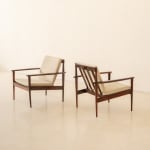











Grete Jalk
Armchair (2 units - pair)
| Restored |
Solid Rosewood, Nubuck Leather
Solid Rosewood, Nubuck Leather
H 29.14 in. x W 28.55 in. x D 30.52 in. | SH 12.6 in.
H 74 cm x W 72.5 cm x D 77.5 cm | SH 32 cm
H 74 cm x W 72.5 cm x D 77.5 cm | SH 32 cm
BO.GRJ.001-002
Further images
-
(View a larger image of thumbnail 1
)

-
(View a larger image of thumbnail 2
)

-
(View a larger image of thumbnail 3
)

-
(View a larger image of thumbnail 4
)

-
(View a larger image of thumbnail 5
)

-
(View a larger image of thumbnail 6
)

-
(View a larger image of thumbnail 7
)

-
(View a larger image of thumbnail 8
)

-
(View a larger image of thumbnail 9
)

-
(View a larger image of thumbnail 10
)

-
(View a larger image of thumbnail 11
)

-
(View a larger image of thumbnail 12
)

This gorgeous armchair was created by the Danish designer Grete Jalk and produced in Brazil in c. 1951 by Móveis Ambiente under the order of the architect and designer Rino...
This gorgeous armchair was created by the Danish designer Grete Jalk and produced in Brazil in c. 1951 by Móveis Ambiente under the order of the architect and designer Rino Levi. The model is a design for Residencia Milton Guper, built by Rino Levi.
The piece comprises a structure in solid Rosewood with slatter backs and thing cushions in leather, reupholstered following archival images.
Grete Jalk was a furniture designer when it was almost an exclusively male profession. One of her earliest projects was a 1947 furniture set for the “modern professional woman” with a sofa bed, desk, and wall-mounted storage system. In 1953 Jalk opened her design studio shortly after successfully exhibiting at the ninth Milan Triennale.
Rino Levi was one of the leading names in consolidating modern Brazilian architecture. His trajectory evolves innovative projects and participation in architecture discussion spaces. Rino Levi has a legacy in architectural design, with his creative solutions that integrate art and technique, but also for the way of thinking about architecture in Brazil, in his constant struggle to consolidate this professional field and create a unique way to design.
The piece comprises a structure in solid Rosewood with slatter backs and thing cushions in leather, reupholstered following archival images.
Grete Jalk was a furniture designer when it was almost an exclusively male profession. One of her earliest projects was a 1947 furniture set for the “modern professional woman” with a sofa bed, desk, and wall-mounted storage system. In 1953 Jalk opened her design studio shortly after successfully exhibiting at the ninth Milan Triennale.
Rino Levi was one of the leading names in consolidating modern Brazilian architecture. His trajectory evolves innovative projects and participation in architecture discussion spaces. Rino Levi has a legacy in architectural design, with his creative solutions that integrate art and technique, but also for the way of thinking about architecture in Brazil, in his constant struggle to consolidate this professional field and create a unique way to design.